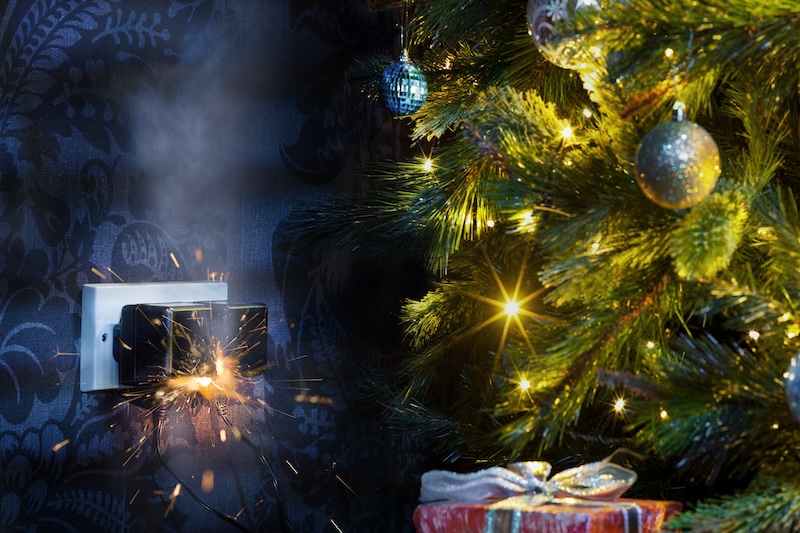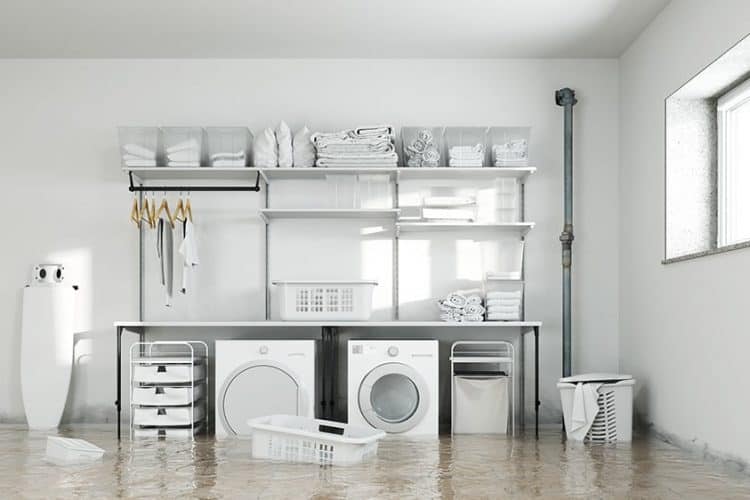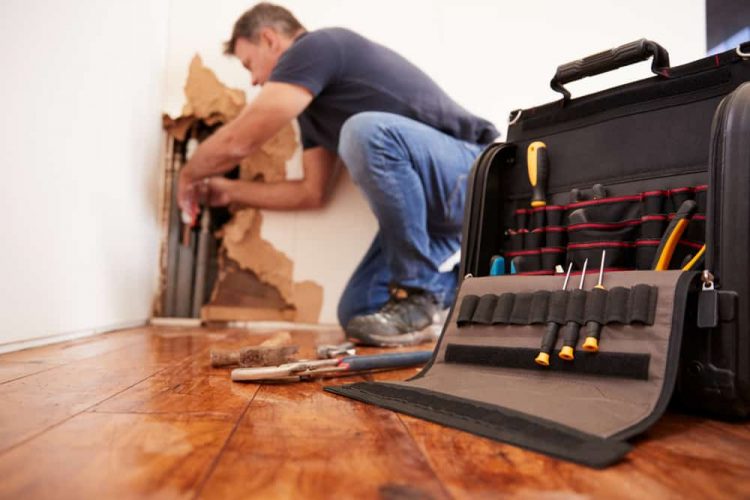When you think of the festive holiday season, you might picture twinkling lights, crackling fireplaces, and aromatic candles to set the scene. But, according to the National Fire Protection Association (NFPA), December is the leading month for house fires and the need for fire damage restoration services. In fact, between 2017 and 2021 alone, 150 Christmas tree fires were reported by U.S. fire departments, approximately 790 home fires began from decorations catching fire, about 5,700 home fires were started by candles, and almost 50% of house fires were related to cooking. So, as you prepare for the festive season, it’s important to stay mindful of fire prevention strategies that can help ensure a safer and merrier holiday for you and your loved ones.

Tips on Mitigating Risks During the Holiday Season
Christmas Trees
- Turn Lights Off: When you’re not around to enjoy the festive glow or when you’re catching some z’s, unplug the Christmas tree.
- Pick a Fresh Tree: Select a freshly cut tree or cut one down yourself. This promotes better water absorption, keeping the tree healthier and less prone to drying out, which can make it more flammable.
- Keep the Tree Watered: A well-watered tree can help prevent it from becoming a fire hazard by making it more resistant to flames.
- Choose a Cool Location: Position the tree away from any heat sources like fireplaces, radiators, or heaters. A cool spot also helps the tree stay fresher for longer. Avoid spots near staircases or close to bedrooms, as fires can spread rapidly through these areas.
- Decorate Responsibly: Opt for decorations that aren’t flammable. This includes choosing non-combustible ornaments and avoiding easily ignitable items.
- Handle Cords Carefully: Use approved, tested Christmas lights and avoid daisy-chaining multiple extension cords. It’s also important to inspect cords for damage before plugging them in.
- Be Cautious with Candles: Keep candles at a safe distance from the tree. Even a small flame can pose a significant risk.
- Pet Patrol: Keep pets from chewing wires or knocking over the tree. If you can’t keep them away, regularly check for any damage they might have caused to lights or decorations.
- Close Doors: Consider closing bedroom doors at night. This can help contain any potential fire and smoke, giving you more time to react and exit in case of an emergency.
Lights
- Inspect Lights Thoroughly: Inspect all lights for damaged wires, sockets, or loose connections. It’s essential to replace faulty parts before decking the halls.
- Set Timers and Unplug Responsibly: Set timers to prevent overheating and always unplug lights when you’re away or going to bed.
- Pay Attention To Outdoor Lights: Ensure outdoor lights are certified for exterior use and keep them away from anything flammable.
- Select Appropriate Extension Cords: Use extension cords made for outdoor or indoor use, depending on where you’re placing the lights. Keeping cords dry is also crucial to avoid electrocution or fires.
- Discard Old Lights: Always replace missing or broken bulbs. Dispose of old lights that might pose a risk due to wear and tear.
- Ensure Unobstructed Exits: Make sure light displays don’t obstruct exits or escape routes in the case of an emergency.
- Practice Safe Ladder Use: Be cautious when using a ladder for decorating high spots. Opt for non-conductive ladders to help prevent electrical hazards.
- Stick to Outlet Use Limits: Don’t overload outlets with too many plugs. Stick to the recommended number of light strands per outlet.
- Never Use Sharp Objects: Avoid using staples, tacks, or nails to hang lights to prevent damaging the wires, which could lead to potential electrical hazards.
- Prioritize Safety for Living Beings: Never use lights as part of a costume, including on your pets, to prevent potential electric shock or burns.
- Store Lights Safely: Properly store lights when you’re not using them to prevent damage and keep them in good condition for the next season.
Candles
- Place In a Safe Spot: Keep candles away from flammable items and place them on stable surfaces within sight.
- Consider Alternatives: Flameless LED candles are the safest option, especially in homes with pets or children, and don’t require such close monitoring.
- Extinguish Properly: Always put out candles before leaving the room or going to sleep. Never leave a burning flame unattended.
- Use Candle Holders: Make use of non-combustible, stable holders for candles to prevent tipping.
- Monitor Children Around Candles: Keep burning candles and matches out of children’s reach and teach them about candle safety.
- Mind the Draperies: Avoid placing candles near curtains, furniture, or any combustible materials.
- Keep a Space Between Candles: Keep candles at least 12 inches away from anything that can catch fire.
- Place Candles Away from Drafts: Drafts, vents, or fast-moving air can cause candles to tip over or flames to spread rapidly.
Cooking
- Maintain Smoke Alarms: Install smoke alarms in the kitchen and nearby areas and test them monthly to make sure they’re in good condition. It’s also a good idea to replace batteries yearly.
- Be Mindful of Clothing: Avoid wearing loose or dangling clothing while cooking to prevent contact with heat sources and catching fire.
- Stay Attentive While Cooking: Never leave cooking unattended, especially when frying, grilling, or boiling food.
- Utilize Timers: Set timers as reminders for ongoing cooking processes, and pay attention to stove or oven settings.
- Watch Children and Pets: Keep children and pets at a safe distance of at least three feet away from cooking areas.
- Clear Surroundings of Flammables: Remove flammable items like towels, oven mitts, and paper or plastic materials from the vicinity of heat sources.
- Maintain Clean Cooking Surfaces: Regularly clean cooking surfaces to prevent grease accumulation – a common cause of kitchen fires.
- Double-Check Appliances: Before leaving the kitchen or home, ensure all stoves, ovens, and appliances are turned off properly.
- Prepare with a Fire Extinguisher: Consider keeping a fire extinguisher in the kitchen and be sure to understand how to use one properly.
Check our article on Common Fire Damage Restoration Myths Debunked!
1-800 WATER DAMAGE Is Your Trusted Fire Damage Restoration Services Provider
We understand that after an emotional event like a fire that damages your property, dealing with fire damage restoration can feel overwhelming. That’s why we’re more than just technicians. We’re companions throughout the process, working hand-in-hand with you and your insurance company to create solutions. From understanding the type of damage caused to implementing the best treatment, we handle the repair process with the utmost care, allowing you to focus on what truly matters – yourself and your loved ones.
For immediate fire and smoke damage restoration, reach out to 1-800 WATER DAMAGE at (800) 928-3732. Rest assured, our thoroughly vetted technicians will provide prompt and compassionate service, helping restore your home and peace of mind.



